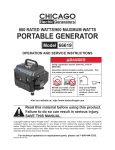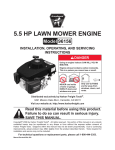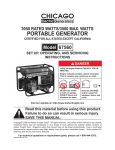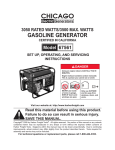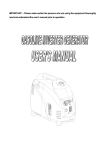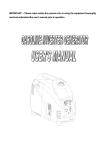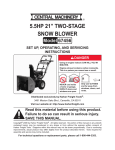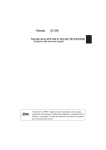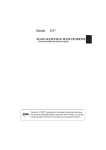Download Chicago Electric 65588 Specifications
Transcript
Inverter gas generator 65588 Set up, Operating, and Servicing Instructions Using an engine indoors CAN KILL YOU IN MINUTES. Engine exhaust contains carbon monoxide. This is a poison you cannot see or smell. NEVER use inside a home or garage, EVEN IF doors and windows are open. Only use OUTSIDE and far away from windows, doors, and vents. Distributed exclusively by Harbor Freight Tools®. 3491 Mission Oaks Blvd., Camarillo, CA 93011 Visit our website at: http://www.harborfreight.com Read this material before using this product. Failure to do so can result in serious injury. Save this manual. Copyright© 2008 by Harbor Freight Tools®. All rights reserved. No portion of this manual or any artwork contained herein may be reproduced in any shape or form without the express written consent of Harbor Freight Tools. Diagrams within this manual may not be drawn proportionally. Due to continuing improvements, actual product may differ slightly from the product described herein. Tools required for assembly and service may not be included. For technical questions or replacement parts, please call 1-800-444-3353. Contents Storage����������������������������������������14 Troubleshooting���������������������� 15 Important SAFETY Information���������������������������� 3 Parts Lists and Diagrams� 17 Set up precautions�������������������� 3 Operating precautions������������ 4 Refueling Precautions:����������� 6 Basic Specifications������������� 6 Unpacking���������������������������������� 6 Operating Instructions������ 7 Engine Controls�������������������� 7 Checking and Filling Engine Oil������������������������������� 8 Checking and Filling Fuel�� 9 Starting the Engine�������������� 9 Break-in Period�������������������� 10 Body Parts List “A”������������������ 17 Body Diagram “A”���������������������� 17 Generator Parts List “B”������� 18 Generator Diagram “B”���������� 18 Engine Parts List “C”��������������� 19 Engine Assembly Diagram “C”�������������������������������������������������20 Limited 1 year / 90 Day warranty������������������������������ 21 Emission Control System Warranty������������������������������ 22 Equipment Operation���������� 10 Technical Specifications�� 11 Servicing���������������������������������� 11 Maintenance Procedures����� 11 Engine Oil Change��������������� 11 Spark Plug Maintenance�� 12 Fuel Filter Replacement (if equipped)������������������������� 13 Cleaning, Maintenance, and Lubrication Schedule���������� 13 After Initial 20 Operation Hour Period:� 13 Every 25 Operation Hours Thereafter:����������� 13 Every 50 Operation Hours:������������������������������������ 13 Every 100 Operation Hours:������������������������������������ 13 Every 300 Operation Hours:������������������������������������ 13 SKU 65588 For technical questions, please call 1-800-444-3353. Page 2 Save This Manual NOTICE is used to address practices not related to personal injury. Keep this manual for the safety warnings and precautions, assembly, operating, inspection, maintenance and cleaning procedures. Write the product’s serial number in the back of the manual near the assembly diagram (or month and year of purchase if product has no number). Keep this manual and the receipt in a safe and dry place for future reference. CAUTION, without the safety alert symbol, is used to address practices not related to personal injury. WARNING! Read all instructions. Failure to follow all instructions listed below may result in fire, serious injury and/or DEATH. The warnings and precautions discussed in this manual cannot cover all possible conditions and situations that may occur. It must be understood by the operator that common sense and caution are factors which cannot be built into this product, but must be supplied by the operator. Important SAFETY Information In this manual, on the labeling, and all other information provided with this product: This is the safety alert symbol. It is used to alert you to potential personal injury hazards. Obey all safety messages that follow this symbol to avoid possible injury or death. DANGER indicates a hazardous situation which, if not avoided, will result in death or serious injury. WARNING indicates a hazardous situation which, if not avoided, could result in death or serious injury. CAUTION, used with the safety alert symbol, indicates a hazardous situation which, if not avoided, could result in minor or moderate injury. SKU 65588 SAVE THESE INSTRUCTIONS Set up precautions 1. Keep access doors on enclosures locked. 2. Have licensed electrician do all electrical work, including all earth-ground connections. A qualified mechanic or licensed electrician must do all maintenance. 3. Keep area and equipment dry. 4. Keep all guards in place and in proper working order. 5. Gasoline fuel and fumes are flammable, and potentially explosive. Use proper fuel storage and handling procedures. Do not store fuel or other flammable materials nearby. For technical questions, please call 1-800-444-3353. Page 3 6. Have multiple ABC class fire extinguishers nearby. 7. Operation of this equipment may create sparks that can start fires around dry vegetation. A spark arrestor may be required. The operator should contact local fire agencies for laws or regulations relating to fire prevention requirements. 8. Set up and use only on a flat, level, well-ventilated surface. 9. Wear ANSI-approved safety goggles, heavy-duty work gloves, and dust mask/respirator during set up. 10. Use only oil (SAE 10W30) and fuel 87+ Octane as noted in the “Specifications” section of this manual. 2. Only use OUTSIDE and far away from windows, doors, and vents. 3. Unconditioned electrical output can damage sensitive equipment; do not use to power sensitive electronic equipment without appropriate line conditioner (sold separately). 4. Keep children away from the equipment, especially while it is operating. 5. Do not leave the equipment unattended when it is running. Turn off the equipment (and remove safety keys, if available) before leaving the work area. 6. People with pacemakers should consult their physician(s) before use. Electromagnetic fields in close proximity to a heart pacemaker could cause pacemaker interference or pacemaker failure. Caution is necessary when near the engine’s magneto or recoil starter. 7. Use only accessories that are recommended by Harbor Freight Tools for your model. Accessories that may be suitable for one piece of equipment may become hazardous when used on another piece of equipment. 8. Do not operate in explosive atmospheres, such as in the presence of flammable liquids, gases, or dust. Gasoline-powered engines may ignite the dust or fumes. 9. Stay alert, watch what you are doing and use common sense when operat- Operating precautions 1. Carbon Monoxide Hazard Using an engine indoors CAN KILL YOU IN MINUTES. Engine exhaust contains carbon monoxide. This is a poison you cannot see or smell. NEVER use inside a home or garage, EVEN IF doors and windows are open. SKU 65588 For technical questions, please call 1-800-444-3353. Page 4 ing this piece of equipment. Do not use this piece of equipment while tired or under the influence of drugs, alcohol or medication. 10. Parts, especially exhaust system components, get very hot during use. Stay clear of hot parts. 11. Do not cover the engine or equipment during operation. 12. Keep the equipment, engine, and surrounding area clean at all times. 13. Use the equipment, accessories, etc., in accordance with these instructions and in the manner intended for the particular type of equipment, taking into account the working conditions and the work to be performed. Use of the equipment for operations different from those intended could result in a hazardous situation. 17. Before use, check for misalignment or binding of moving parts, breakage of parts, and any other condition that may affect the equipment’s operation. If damaged, have the equipment serviced before using. Many accidents are caused by poorly maintained equipment. 18. Use the correct equipment for the application. Do not modify the equipment and do not use the equipment for a purpose for which it is not intended. Service precautions 1. a.Turn the engine switch to its “OFF” position. b.Allow the engine to completely cool. 14. Do not operate the equipment with known leaks in the engine’s fuel system. 15. This product contains or, when used, produces a chemical known to the State of California to cause cancer and birth defects or other reproductive harm. (California Health & Safety Code § 25249.5, et seq.) 16. When spills of fuel or oil occur, they must be cleaned up immediately. Do not leave fuel, or oil soaked rags sitting around, even for short periods of time. Dispose of (or store) any fuel, or oil soaked rags in a bottomventilated, covered, metal container. Dispose of fluids and cleaning materials as per any local, state, or federal codes and regulations. SKU 65588 Before service, maintenance, or cleaning: c. Then, remove the spark plug wire(s) from the spark plug(s). 2. Keep all safety guards in place and in proper working order. Safety guards include muffler, air cleaner, mechanical guards, and heat shields, among other guards. 3. Do not alter or adjust any part of the equipment or its engine that is sealed by the manufacturer or distributor. Only a qualified service technician may adjust parts that may increase or decrease governed engine speed. 4. Wear ANSI-approved safety goggles, heavy-duty work gloves, and dust mask/respirator during service. 5. Maintain labels and nameplates on the equipment. These carry impor- For technical questions, please call 1-800-444-3353. Page 5 6. tant information. If unreadable or missing, contact Harbor Freight Tools for a replacement. Run Time @ 50% Load Approximately 4 Hours (with full tank). Sound Level 93 dB Have the equipment serviced by a qualified repair person using only identical replacement parts. This will ensure that the safety of the equipment is maintained. Do not attempt any service or maintenance procedures not explained in this manual or any procedures that you are uncertain about your ability to perform safely or correctly. Power Output 7. Store equipment out of the reach of children. 8. Follow scheduled engine and equipment maintenance. Refueling Precautions: a.Do not smoke, or allow sparks, flames, or other sources of ignition around the equipment, especially when refuelling. b.Do not refill the fuel tank while the engine is running or hot. c. Do not fill fuel tank to the top. Leave a little room for the fuel to expand as needed. d.Refuel in an exterior, well-ventilated area only. Basic Specifications Fuel Engine Oil Type 89+ Octane unleaded gasoline. Capacity 0.6 US Gallons Type SAE 30W Above 32° F SAE 10W-30 Below 32° F Capacity 0.2 QT. SKU 65588 Receptacles 950 W Rated, 1000 W Peak 120 V ~ 7.9 A Rated Duplex Receptacle 12 V DC 65 Receptacle. Note: Additional specifications found in the Technical Engine Specifications chart in this manual. The emission control system for this engine is warranted for standards set by the U.S. Environmental Protection Agency and by the California Air Resources Board (also known as CARB). For warranty information, refer to the last pages of this manual. At high altitudes, the engine’s carburetor, governor (if so equipped), and any other parts that control the fuel-air ratio will need to be adjusted by a qualified mechanic to allow efficient highaltitude use and to prevent damage to the engine and any other devices used with this product. Unpacking When unpacking, check to make sure that the item is intact and undamaged. If any parts are missing or broken, please call Harbor Freight Tools at the number shown on the cover of this manual as soon as possible. For technical questions, please call 1-800-444-3353. Page 6 Read the entire Important Safety Information section at the beginning of this manual including all text under subheadings therein before set up or use of this product. Figure 1 Pull (Recoil) Starter Handle (4) Engine (on/off) Switch To prevent serious injury: A Operation of this equipment may create sparks that can start fires around dry vegetation. A spark arrestor may be required. The operator should contact local fire agencies for laws or regulations relating to fire prevention requirements. B C D 3 Operating Instructions Read the entire Important Safety Information section at the beginning of this manual including all text under subheadings therein before set up or use of this product. To prevent serious injury from accidental starting: Turn the Power Switch of the equipment to its “OFF” position, disconnect the spark plug wire(s) before assembling or making any adjustments to the equipment. Engine Controls 1. Engine Switch, disables engine in “OFF” position. SKU 65588 AC 120 V Outlets DC Outlet Economy (on/off) Switch 2. Economy Control Switch decreases output of Generator when less power is needed. This will result in better fuel efficiency and lower noise volume. 3. Overload Light (A) comes on when the Inverter Control Unit overheats, or the AC output rises above 7.9 AMPS. The electronic breaker will then activate, stopping power generation in order to protect both the Generator and any connected devices. The AC Pilot Light (B) (green) will go off and the Overload Light (C) (red) will stay on. The Generator Engine will stop running. When this happens, proceed as follows: For technical questions, please call 1-800-444-3353. Page 7 a.Turn off any connected electric devices. Figure 2 b.Reduce the total wattage of connected electric devices. c. Check for any blockages in the cooling air inlet, and remove, or repair before reusing. d.After checking and fixing the problem, restart the Generator. 4. DC Outlet, used to charge a 12 Volt auto, or marine battery. Make sure the leads of the charger are correctly connected to the positive and negative battery terminals. 5. Fuel Cock (3) should be set to “OFF” (full clockwise position) if the Generator is being re-fueled, is not being used and/or is being stored. It should be “ON” (full counterclockwise position) at all times when the Generator is running. 6. Recoil Starter Handle (4) is used for starting the Generator. 7. AC 120 Volt Outlets are used to power electrical equipment using the Generator. The AC Pilot Light (B) is lit. If it is not, unplug the electrical equipment and check the problem before continuing. Checking and Filling Engine Oil CAUTION! Your Warranty is VOID if the engine’s crankcase is not properly filled with oil (SAE 10W30) before each use. Before each use, check the oil level. Do not run the engine with low or no engine oil. Running the engine with no or low engine oil WILL permanently damage the engine. SKU 65588 Oil Filler Cap (Dip Stick Attached) 8. Remove the Oil Filler Cap (Dipstick is attached), and wipe it off with a clean rag. See Figure 2. 9. Reinsert the dipstick completely (do not screw on the Oil Filler Cap) and remove it to check the oil level. The oil level should be between the high and low marks on the dipstick. 10. If the oil level is below the low mark add the appropriate type of oil until the oil level is between the high and the low marks. Oil type: 32° F or above = SAE 30W Below 32° F = SAE 10W-30 11. Inspect “O” Ring condition on the cap. Replace if damaged or missing. 12. Replace the Oil Dipstick. CAUTION! Do not run the engine with too little or too much oil. The engine will be permanently damaged. For technical questions, please call 1-800-444-3353. Page 8 Checking and Filling Fuel WARNING! To prevent serious injury from fire: Fill the fuel tank in a well-ventilated area away from ignition sources. Do not smoke. 1. To fill the Fuel Tank, first wipe off the Fuel Tank Cap and the surrounding area. 2. Unscrew, and remove the Fuel Tank Cap. Remove the Strainer. 3. Check the fuel level by peering into the tank. If the fuel level is well below the top of the tank, the fuel should be topped off before using. 4. Mix fuel stabilizer (not included) with 89+ octane unleaded gasoline according to fuel stabilizer directions. c. Read the Equipment Operation section that follows. 1. Unplug all loads from the Gas Generator before starting to prevent permanent damage to any appliances, tools, or equipment. Figure 3 Recoil Starter Handle (4) Fuel Cock (3) 5. Fill the Fuel Tank to about 1 inch under the fill neck (fuel should barely cover bottom of the Strainer). 2. 6. Replace the Strainer and Fuel Tank Cap. Turn the engine Fuel Cock (3) full clockwise to its “OPEN” position. See Figure 3. 3. Open Fuel Tank Air Vent (located on top of Fuel Cap) to full counterclockwise position. 4. Turn the Engine Switch (on the Control Panel) to its “ON” position, and the Economy Switch to it’s “OFF” position. Starting the Engine Inspect engine and equipment looking for damaged, loose, and missing parts before set up and starting. If any problems are found, do not use equipment until fixed properly. Before starting the engine: a.Inspect the equipment and engine. b.Fill the engine with the proper amount and type of fuel and oil. SKU 65588 For technical questions, please call 1-800-444-3353. Page 9 The first 20 hours of operation is the break-in period. Figure 4 2. During the first 3 hours of use: • Do not apply a heavy electrical load to the equipment. • Do not operate the engine at its maximum speed, use the Economy Control Switch (on Control Panel). 3. • Change the engine oil. Choke Lever 5. Then, push the engine Choke Lever to its “CHOKE” position (far right). Set the Choke Lever in the “RUN” position (far left) when starting a warm engine. See Figure 4. 6. Grasp the Recoil Starter Handle (4), and pull slowly until resistance is felt. While holding the handle, allow the starter rope to rewind slowly. Then, pull the Recoil starter handle with a rapid, full arm stroke. Once again while holding the handle, allow the rope to rewind slowly. Repeat as necessary, until the engine starts. 7. After the engine starts and warms up, slowly move the Choke Lever to its “RUN” position. 8. IMPORTANT: Allow the engine to run at no load until warm (1-5 minutes) after each start-up to allow the engine to stabilize. Break-in Period 1. Breaking-in the engine will help to ensure proper equipment and engine operation, and will extend the engine’s lifespan. The warranty is void if the engine is not broken in properly. SKU 65588 After the first 20 hours of use: NOTE: Under normal operating conditions subsequent maintenance follows the schedule explained in the Maintenance and Servicing section. Equipment Operation 1. Follow correct starting and break-in procedures in previous section. NOTE: Avoid connecting the Generator to commercial power outlets. Avoid connecting the Generator in parallel with any other generators. 2. Plug in AC power cord from the item needing power. Always plug in largest load object first. 3. To save power and gasoline, turn on the Economy Control Switch. If the Generator sounds like it is faultering, or lugging under it’s electrical load, turn off the Economy Control Switch. 4. When finished using the Generator, unplug all electrical cords. 5. To prevent accidents, turn off the engine and disconnect its spark plug wire after use. Wait for the engine to cool, clean external parts with clean cloth, then store the equipment out For technical questions, please call 1-800-444-3353. Page 10 of children’s reach according to the Storage instructions in this manual. Maintenance Procedures Many maintenance procedures, including those not detailed in this manual, will need to be performed by a qualified technician for safety. If you have any doubts about your ability to safely service the equipment or engine, have a qualified technician service the equipment instead. Technical Specifications Engine Type Fuel Engine Oil Type Capacity Type Capacity Type Spark Plug Gap Engine Maximum Speed Air Cooled, 4 Cycle, OHV, Gas Engine. 89+ octane unleaded gasoline 0.6 Gallons SAE 30W (above 32° F) SAE 10W30 (at 32° F or below) .2 Quarts Standard CR4HSB .024” to .028” 6500 RPM Note: Warranty is void if proper maintenance and servicing procedures are not followed. Engine Oil Change CAUTION! Oil is very hot during operation and can cause burns. Wait for engine to cool before changing oil. Servicing To prevent serious injury from accidental starting: Turn the Power Switch of the equipment to its “OFF” position, wait for the engine to cool, and disconnect the spark plug wire(s) before performing any inspection, maintenance, or cleaning procedures. 1. First remove Housing Cover (6). 2. Place a drain pan (not included) underneath the crankcase’s drain plug. 3. Remove the drain plug and, if possible, tilt the crankcase slightly to help drain the oil out. Recycle used oil. 4. Replace the drain plug, (check the sealing “O” Ring condition and replace if damaged) and tighten the drain plug. 5. Refill the oil to the proper level following the instructions under the Starting the Engine section. To prevent serious injury from equipment failure: Do not use damaged equipment. If abnormal noise, vibration, or excess smoking occurs, have the problem corrected before further use. SKU 65588 Air Filter Element Maintenance 1. Wipe off the Air Cleaner (1C) cover, and remove it. For technical questions, please call 1-800-444-3353. Page 11 Figure 5 2. Inspect the spark plug: If the electrode is oily, clean it using a clean, dry rag. If the electrode has deposits on it, polish it using emery paper. If the white insulator is cracked or chipped, the spark plug needs to be replaced. 3. When installing a new spark plug, adjust the plug’s gap to the specification on the Technical specification chart. Do not pry against the electrode or the insulator, the spark plug can be damaged. 4. Install the new spark plug or the cleaned spark plug into the engine. Gasket-style: Finger-tighten until the gasket contacts the cylinder head, then about 1/2-2/3 turn more. Non-gasket-style: Finger-tighten until the plug contacts the head, then about 1/16 turn more. 5. Apply dielectric spark plug boot protector (not included) to the end of the spark plug and reattach the wire securely. Choke Lever Air Cleaner Cover 2. Remove the Air Filter Element. See Figure 5. 3. Cleaning: a.For foam filter elements: Wash the element in warm water and mild detergent several times. Rinse. Squeeze out excess water and allow it to dry completely. Soak the filter in lightweight oil briefly, then squeeze out the excess oil. b. Install the new filter or the cleaned filter. Secure the Air Cleaner Cover before use. Spark Plug Maintenance 1. Remove Spark Plug Access Cover (17). Disconnect spark plug wire from end of plug. Clean out debris from around spark plug and remove the spark plug. SKU 65588 For technical questions, please call 1-800-444-3353. Page 12 Fuel Filter Replacement (if equipped) WARNING! To prevent serious injury from fire: Replace the fuel filter in a well-ventilated area away from ignition sources. Do not smoke. 1. Wait for engine to cool completely before proceeding. 2. Wear protective gear including, ANSIapproved safety goggles, NIOSHapproved dust mask/respirator, and nitrile gloves. 3. Close fuel valve leading from gas tank completely. 4. Take note of the fuel filter’s orientation. 5. Place a suitable container under the fuel filter. 6. Disconnect the fuel lines leading to and from the fuel filter and allow fuel to drain onto the container. 7. Install new fuel filter in the same orientation. Make sure to properly secure both fuel lines. 8. Clean up and properly dispose of all fuel. 9. Wait for at least one hour before use to allow all residual fuel vapors to dissipate. To prevent fire, do not start the engine while the smell of fuel hangs in the air. Remember to open the fuel valve before restarting the engine. It may take a little longer than usual to start the engine because the fuel needs to refill the fuel line and new filter. SKU 65588 Cleaning, Maintenance, and Lubrication Schedule Note: This maintenance schedule is intended solely as a general guide. If performance decreases or if equipment operates unusually, check systems immediately. The maintenance needs of each piece of equipment will differ depending on factors such as duty cycle, temperature, air quality, fuel quality, and other factors. Note: These procedures are in addition to the regular checks and maintenance explained as part of the regular operation of the engine and equipment. After Initial 20 Operation Hour Period: a.Change engine oil. Every 25 Operation Hours Thereafter: a.Clean/replace air filter element. b.Inspect/clean spark plug. Every 50 Operation Hours: a.Change engine oil. b.Replace fuel filter (if equipped). Every 100 Operation Hours: a.Replace spark plug. b.Replace air filter element. Note: All maintenance procedures scheduled for 25, 50, and 100 operation hours should be performed at least yearly. Every 300 Operation Hours: a.Clean fuel tank and carburetor. b.Clean carbon build-up from combustion chamber. For technical questions, please call 1-800-444-3353. Page 13 Storage 1. Wait for engine to cool, then clean engine with clean cloth. 2. When the equipment is to remain idle for longer than 20 days, prepare the engine for storage as follows: a.Change engine oil and empty fuel tank. b.Either leave fuel tank empty or refill fuel tank with fresh unleaded gasoline. After filling, run engine for about 5-10 minutes to circulate the gasoline through the carburetor. Wait for engine to cool before proceeding. c. Clean out area around spark plug. Remove spark plug and pour one tablespoon of engine oil into cylinder through spark plug hole. d.Reinstall spark plug, but leave spark plug wire disconnected. e.Pull recoil starter to distribute oil in cylinder. Stop after one or two revolutions when you feel the piston start the compression stroke (when you start to feel resistance). f. Disconnect battery cables (if equipped). 3. Cover and store in a dry, well-ventilated area out of reach of children. 4. Before starting the engine after storage, keep in mind that untreated gasoline will deteriorate quickly. Drain the fuel tank and filter, and change to fresh fuel if untreated gasoline has been sitting for a month, if treated gasoline has been sitting beyond the fuel stabilizer’s recommended time period, or if the engine does not start properly. SKU 65588 For technical questions, please call 1-800-444-3353. Page 14 Troubleshooting Problem Engine will not start Possible Causes Fuel Related: 1. No fuel in tank or Fuel Cock closed. 2. Choke not in start position, especially with cold engine. 3. Low quality or deteriorated, old gasoline. 4. Dirty fuel passageways blocking fuel flow. Engine misfires Engine stops suddenly Probable Solutions Fuel Related: 1. Fill fuel tank and open fuel valve. 2. Move choke to start position if engine is cold. 3. Use only fresh 89+ octane unleaded gasoline. 4. Clean out passageways using fuel additive. Heavy deposits may require further cleaning. 5. Too much fuel in chamber. This can 5. Turn choke to run position. Remove be caused by the carburetor needle spark plug and pull the start handle sticking. several times to air out the chamber. Reinstall spark plug and set choke to start position. Ignition (spark) Related: Ignition (spark) Related: 1. Spark plug wire not connected 1. Connect spark plug wire properly. securely. 2. Spark plug electrode wet or dirty. 2. Clean spark plug. 3. Incorrect spark plug gap. 3. Correct spark plug gap. 4. Spark plug wire or spark plug 4. Replace spark plug wire and/or broken. spark plug. 5. Incorrect spark timing or faulty 5. Have qualified technician diagnose/ ignition system. repair ignition system. Compression Related: Compression Related: 1. Cylinder not lubricated. Problem 1. Pour tablespoon of oil into spark after long storage periods. plug hole. Crank engine a few times and try to start again. 2. Loose or broken spark plug. 2. Tighten spark plug. If that does not (Hissing noise will occur when trying work, replace spark plug. to start.) 1. Spark plug wire loose. 1. Check wire connections. 2. Incorrect spark plug gap or 2. Re-gap or replace spark plug. damaged spark plug. 3. Defective spark plug wire. 3. Replace spark plug wire. 4. Old or low quality gasoline. 4. Use only fresh 89+ octane unleaded gasoline. 1. Low oil shutdown. 1. Fill engine oil to proper level. Check engine oil before EVERY use. 2. Fuel tank empty or full of impure or 2. Fill fuel tank with fresh 89+ octane low quality gasoline. unleaded gasoline. 3. Defective fuel tank cap creating 3. Test/replace fuel tank cap. vacuum, preventing proper fuel flow. Follow all safety precautions whenever diagnosing or servicing the equipment or engine. SKU 65588 For technical questions, please call 1-800-444-3353. Page 15 Troubleshooting Problem Engine knocks Possible Causes 1. Old or low quality gasoline. 2. Engine overloaded. Engine backfires 3. Incorrect spark timing, deposit buildup, worn engine, or other mechanical problems. 1. Impure or low quality gasoline. Probable Solutions 1. Fill fuel tank with fresh 89+ octane unleaded gasoline. 2. Do not exceed equipment’s load rating. 3. Have qualified technician diagnose and service engine. 1. Fill fuel tank with fresh 89+ octane unleaded gasoline. 2. Engine too cold. 2. Use cold weather fuel and oil additives to prevent backfiring. 3. Choke not open after engine warm. 3. Move choke to run position after engine warms up. 4. Engine not properly adjusted for 4. Qualified technician must adjust high altitude operation. engine at altitudes greater than 5,000 feet above sea level. 5. Intake valve stuck, choke stuck, 5. Have qualified technician diagnose incorrect timing, clogged carburetor, and service engine. or overheated engine. Follow all safety precautions whenever diagnosing or servicing the equipment or engine. PLEASE READ THE FOLLOWING CAREFULLY The manufacturer and/or distributor has provided the parts list and assembly diagram in this manual as a reference tool only. Neither the manufacturer or distributor makes any representation or warranty of any kind to the buyer that he or she is qualified to make any repairs to the product, or that he or she is qualified to replace any parts of the product. In fact, the manufacturer and/ or distributor expressly states that all repairs and parts replacements should be undertaken by certified and licensed technicians, and not by the buyer. The buyer assumes all risk and liability arising out of his or her repairs to the original product or replacement parts thereto, or arising out of his or her installation of replacement parts thereto. SKU 65588 For technical questions, please call 1-800-444-3353. Page 16 Parts Lists and Diagrams Body Parts List “A” Part 1 2 3 4 5 6 7 9 10 11 12 13 14 15 Description Tapping Screws Control Panel Fuel Cock Recoil Starter Handle Right Engine Cover Generator Housing Cover Hex Screws Fuel Cap Assembly Fuel Tank Sleeve Holder Fuel Tank Fuel Tank Rubber Buffer Fuel Tank Bracket Motor Assembly Hex Screws Body Parts List “A” Q’ty 4 1 1 1 1 1 6 1 1 1 2 1 1 4 Part 16 17 18 19 20 21 22 23 24 25 26 27 28 Description Rear Engine Cover Spark Plug Access Cover Right Generator Cover Hex Screws Oil Pump Base Rubber Buffer Housing Hex Screws Oil Cap Oil Filler Neck Inverter Rubber Buffer Hex Screws Inverter Q’ty 1 1 1 7 1 1 4 4 1 1 4 4 1 Body Diagram “A” SKU 65588 For technical questions, please call 1-800-444-3353. Page 17 Generator Parts List “B” Part 1B 2B 3B 4B 5B 6B 7B 8B 9B 10B 11B 12B 13B Description Tapping Screws Fan Cover Tapping Screws Fan Ventilator Back Plate Rotor Tapping Screws Rotor Shaft Holder Tapping Screws Rotor Shield Hex Screws Right Cover Tapping Screws Part Q’ty 4 1 2 1 1 1 4 1 4 1 1 1 2 14B 15B 16B 17B 18B 19B 20B 21B 22B 23B 24B 25B 26B 27B 28B Description Cover Muffler Compartment Engine Assembly Flywheel Shield Carburetor Insulator Left Cover Carburetor Air Cleaner Tapping Screws Gasoline-Break Switch Gasoline Pump Tapping Screws Engine Stand Bracket Engine Stand Rubber Buffers Engine Base Q’ty 1 1 1 1 1 1 1 1 2 1 1 1 1 4 1 NOTE: When ordering, or referring to parts for “Generator”, use the suffix “B” after each individual part number. Generator Diagram “B” SKU 65588 For technical questions, please call 1-800-444-3353. Page 18 Engine Parts List “C” Part 1C 2C 3C 4C 5C 6C 7C 8C 9C 12C 13C 18C 19C 20C 21C 22C 23C 24C 25C 26C 28C-1 28C-2 28C-3 28C-4 29C 30C 31C 32C 33C 34C 35C 36C 37C 38C 39C 40C 43C 44C 45C 46C 47C 48C 49C 50C 51C 52C 55C 56C 57C 58C 59C 60C Discription Air Cleaner (outside) Cover Filter Net Screw M5 X 75 Air Cleaner (Inside) Cover Gasket Carburetor Gasket Intake Pipe Gasket Screw M5 X 12 Block Cover Oil-Seal Cylinder Pin 6 X 12 Board Screw M3 X 5 Sea Saw Plate Reed Valve Crank Shaft Key 3 X 5 X 13 Piston Piston Ring (No 1) Piston Ring (No 2) Oil-Ring Ring Piston Pin Link Lever Link Lever Cover Shift Fork Screw M5 X 25 Ignition Starter Screw M5 X 20 Screw 2 Case Oil-Seal Screw M5 X 25 Seal Oil Dip-Stick Engine Oil Protector Magneto Rotor Component Screw 1 Start Reel Nut M10 X 1.25 Magneto Cover Starter Nut M5 Screw M5 X 16 Muffler Cover Nut M5 Double-Edge Bolt Screw M5 X 35 Muffler SKU 65588 Q’ty 1 1 2 1 1 1 1 1 1 5 1 2 1 2 1 1 1 1 1 1 1 1 1 1 2 1 1 1 1 2 1 1 1 1 2 1 1 1 1 1 1 1 1 1 1 3 3 1 3 2 1 1 Part 61C 62C 63C 64C 65C 66C 67C 68C 69C 70C 83C 84C 85C 86C 87C 88C 89C 90C 91C 92C Discription Muffler Baffle Rocker Rocker-Shaft Exhaust Valve Intake Valve Valve Spring Valve Spring Seat Spark Plug Gasket Cover Gear Pin Gasket 4 Timing Gear Valve Pole Valve Pillar Cam Wheel Long Pin Sleeve Pin Side Block Cover Q’ty 1 2 1 1 1 2 2 1 1 1 1 1 1 2 2 1 2 1 2 1 NOTE: When ordering, or referring to parts for “Engine”, please add the suffix “C” after each individual part number. For technical questions, please call 1-800-444-3353. Page 19 Engine Assembly Diagram “C” NOTE: When ordering, or referring to parts for “Engine”, use the suffix “C” after each individual part number. SKU 65588 For technical questions, please call 1-800-444-3353. Page 20 Limited 1 year / 90 Day warranty Harbor Freight Tools Co. makes every effort to assure that its products meet high quality and durability standards, and warrants to the original purchaser that for a period of ninety days from date of purchase that the engine/motor, the belts (if so equipped), and the blades (if so equipped) are free of defects in materials and workmanship. Harbor Freight Tools also warrants to the original purchaser, for a period of one year from date of purchase, that all other parts and components of the product are free from defects in materials and workmanship (90 days if used by a professional contractor or if used as rental equipment). This warranty does not apply to damage due directly or indirectly, to misuse, abuse, negligence or accidents, repairs or alterations outside our facilities, normal wear and tear, or to lack of maintenance. We shall in no event be liable for death, injuries to persons or property, or for incidental, contingent, special or consequential damages arising from the use of our product. Some states do not allow the exclusion or limitation of incidental or consequential damages, so the above limitation of exclusion may not apply to you. This warranty is expressly in lieu of all other warranties, express or implied, including the warranties of merchantability and fitness. To take advantage of this warranty, the product or part must be returned to us with transportation charges prepaid. Proof of purchase date and an explanation of the complaint must accompany the merchandise. If our inspection verifies the defect, we will either repair or replace the product at our election or we may elect to refund the purchase price if we cannot readily and quickly provide you with a replacement. We will return repaired products at our expense, but if we determine there is no defect, or that the defect resulted from causes not within the scope of our warranty, then you must bear the cost of returning the product. This warranty gives you specific legal rights and you may also have other rights which vary from state to state. 3491 Mission Oaks Blvd. • PO Box 6009 • Camarillo, CA 93011 • (800) 444-3353 Record Product’s Serial Number Here: Note: If product has no serial number, record month and year of purchase instead. Note: Some parts are listed and shown for illustration purposes only, and are not available individually as replacement parts. SKU 65588 For technical questions, please call 1-800-444-3353. Page 21 Emission Control System Warranty California and United States Emission Control Defects Warranty Statement The California Air Resources Board (herein CARB), the United States Environmental Protection Agency (herein EPA), and Harbor Freight Tools (herein HFT) are pleased to explain the emission control system warranty on your 1995 and later Small Off-Road Engine (herein engine). In California, the engine must be designed, built and equipped to meet the State’s stringent anti-smog standards. Elsewhere within the United States, new off-road, spark-ignition engines certified for model year 1997 and later, must meet similar standards set forth by the EPA. HFT must warrant the emission control system on your engine for the periods of time described below, provided there has been no abuse, neglect or improper maintenance of your engine. Your emission control system may include parts such as the carburetor or fuel-injection system, and the ignition system. Also included may be hoses, belts, connectors and other emissionrelated assemblies. Where a warrantable condition exists, HFT will repair your engine at no cost to you including diagnosis, parts and labor. Manufacturer’s Warranty Coverage The 1995 and later engines are warranted for two (2) years. If any emission-related part on your engine is defective, the part will be repaired or replaced by HFT. Harbor Freight Tools Emission Control Defects Warranty Coverage Engines are warranted for a period of two (2) years relative to emission control parts defects, subject to the provisions set forth below. If any emission related part on your engine is defective, the part will be repaired or replaced by HFT. Owner’s Warranty Responsibilities • As the engine owner, you are responsible for the performance of the required maintenance listed in your Owner’s Manual. HFT recommends that you retain all receipts covering maintenance on your engine, but HFT cannot deny warranty solely for the lack of receipts or for your failure to ensure the performance of all scheduled maintenance. • As the engine owner, you should, however, be aware that HFT may deny you warranty coverage if your engine or a part has failed due to abuse, neglect, improper maintenance, or unapproved modifications. • You are responsible for shipping your engine to a HFT warranty station as soon as a problem exists. Contact the HFT Customer Service department at the number below to make shipping arrangements. The warranty repairs should be completed in a reasonable amount of time, not to exceed 30 days. If you have any questions regarding your warranty rights and responsibilities, you should contact the Harbor Freight Tools Customer Service Department at 1-800-444-3353. Harbor Freight Tools Emission Control Defects Warranty Provisions 1. Length of Coverage HFT warrants to a first retail purchaser and each subsequent purchaser that the engine is free from defects in materials and workmanship that cause the failure of warranted parts for a period of two (2) years after the date of delivery to the first retail purchaser. 2. No Charge Repair or Replacement Repair or replacement of any warranted part will be performed at no charge to the owner if the work is performed through a warranty station authorized by HFT. For emissions warranty service, contact the HFT Customer Service Department at 1-800-444-3353. 3. Consequential Damages Coverage Coverage under this warranty shall also extend to the failure of any engine components caused by the failure of any warranted part while it is still covered under this warranty. 4. Coverage Exclusions Warranty claims shall be filed in accordance with the provisions of the HFT warranty policy explained in the box at the top of the previous page. HFT shall not be liable for any loss of use of the engine, for any alternative usage, for any damage to goods, loss of time, or inconvenience. Warranty coverage shall also be excluded for any part which fails, malfunctions, or is damaged due to failure to follow the maintenance and operating instructions set forth in the Owner’s Manual including, but not limited to: a) Use of parts which are not authorized by HFT b) Improper installation, adjustment or repair of the engine or of any warranted part unless performed by an authorized warranty center c) Failure to follow recommendations on fuel use contained in the Owner’s Manual d) Improper or inadequate maintenance of any warranted parts e) Repairs performed outside of the authorized warranty service dealers f) Alterations by changing, adding to or removing parts from the engine. 5. Service and Maintenance Component parts which are not scheduled for replacement as required maintenance or are scheduled only for regular inspection to the effect of “repair or replace as necessary” are warranted for the warranty period. Any warranted part which is scheduled for replacement as required maintenance is warranted for the period of time up to the first scheduled replacement point for that part. Any replacement part, provided it is equivalent in durability and performance, may be used in performance of maintenance or repairs. The owner is responsible for commissioning a qualified technician/mechanic to perform all required maintenance, as outlined in the Inspection, Cleaning, and Maintenance section in this manual. 6. Warranted Parts 1) 2) SKU 65588 Fuel Metering System i) Carburetor and its internal parts. ii) Fuel pump (if so equipped). iii) Cold start enrichment system. Air Induction System For technical questions, please call 1-800-444-3353. Page 22 3) 4) 5) i) Intake pipe/manifold. ii) Air cleaner. Ignition System i) Spark plug. ii) Magneto ignition system. Catalyst System (if so equipped) i) Exhaust pipe stud. ii) Muffler. iii) Catalytic converter (if so equipped). Miscellaneous Items Used in Above Systems i) Vacuum, temperature and time sensitive valves and switches. ii) Hoses, belts, connectors, and assemblies. SKU 65588 For technical questions, please call 1-800-444-3353. Page 23























